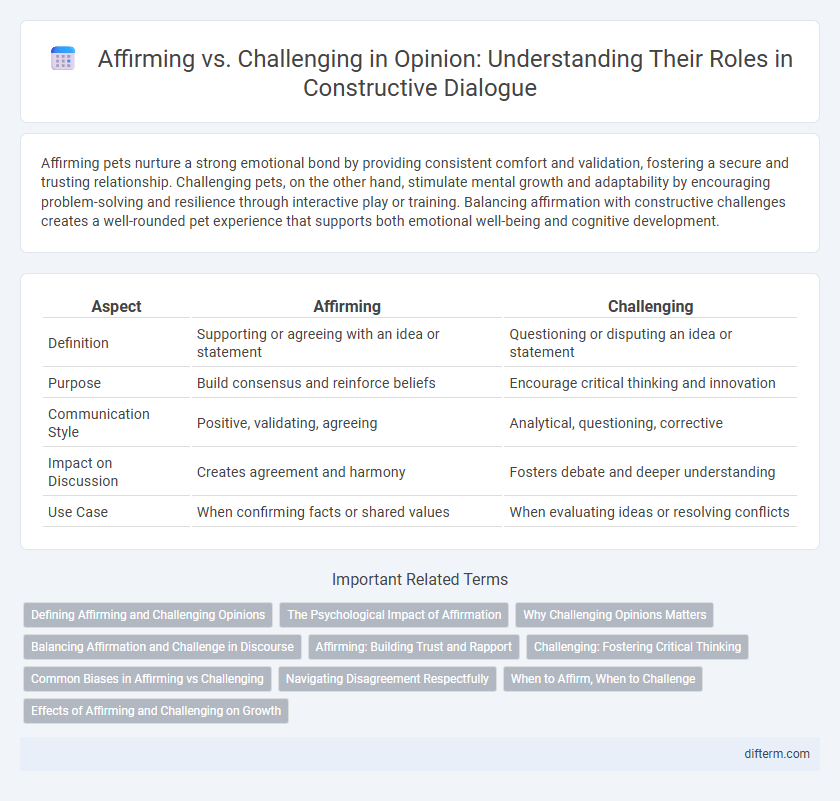Affirming pets nurture a strong emotional bond by providing consistent comfort and validation, fostering a secure and trusting relationship. Challenging pets, on the other hand, stimulate mental growth and adaptability by encouraging problem-solving and resilience through interactive play or training. Balancing affirmation with constructive challenges creates a well-rounded pet experience that supports both emotional well-being and cognitive development.
Table of Comparison
| Aspect | Affirming | Challenging |
|---|---|---|
| Definition | Supporting or agreeing with an idea or statement | Questioning or disputing an idea or statement |
| Purpose | Build consensus and reinforce beliefs | Encourage critical thinking and innovation |
| Communication Style | Positive, validating, agreeing | Analytical, questioning, corrective |
| Impact on Discussion | Creates agreement and harmony | Fosters debate and deeper understanding |
| Use Case | When confirming facts or shared values | When evaluating ideas or resolving conflicts |
Defining Affirming and Challenging Opinions
Affirming opinions reinforce existing beliefs by validating ideas and providing supportive evidence, fostering confidence and consensus. Challenging opinions question assumptions and introduce alternative perspectives, encouraging critical thinking and intellectual growth. Defining these opinions involves recognizing affirming views as alignment with established understanding and challenging views as catalysts for debate and reconsideration.
The Psychological Impact of Affirmation
Affirmation boosts self-esteem by reinforcing an individual's sense of worth and competence, leading to increased motivation and resilience. Neuroscientific studies reveal that affirmation activates brain regions linked to reward and self-processing, reducing stress and defensive responses. Consistent positive reinforcement fosters psychological well-being, enhancing emotional stability and promoting adaptive coping mechanisms.
Why Challenging Opinions Matters
Challenging opinions fosters critical thinking and drives intellectual growth by encouraging individuals to evaluate diverse perspectives. It prevents echo chambers, promotes deeper understanding, and uncovers potential biases or misinformation. Engaging with opposing viewpoints ultimately strengthens arguments and supports a more informed, resilient society.
Balancing Affirmation and Challenge in Discourse
Balancing affirmation and challenge in discourse fosters constructive dialogue by validating perspectives while encouraging critical thinking. Affirmation builds trust and openness, enabling participants to feel heard and respected. Strategic challenges stimulate deeper analysis and innovation, driving conversations beyond superficial agreement toward meaningful understanding and growth.
Affirming: Building Trust and Rapport
Affirming statements strengthen trust by validating feelings and perspectives, fostering a sense of safety in communication. This approach encourages openness and deepens rapport, essential for effective interpersonal relationships. Consistent affirmation reduces misunderstandings and promotes collaborative problem-solving.
Challenging: Fostering Critical Thinking
Challenging ideas stimulates critical thinking by encouraging individuals to analyze assumptions and evaluate evidence rigorously. Engaging in respectful debates fosters intellectual growth and helps uncover biases that affirming perspectives might overlook. Developing the habit of questioning promotes deeper understanding and innovation in problem-solving.
Common Biases in Affirming vs Challenging
Affirming often falls prey to confirmation bias, where individuals selectively gather or interpret evidence supporting their existing beliefs, reinforcing the status quo. Challenging perspectives can trigger cognitive dissonance, leading to resistance or defensive reasoning as people struggle to reconcile conflicting information. Awareness of biases like anchoring and the backfire effect is crucial for balanced judgment, ensuring that affirming does not become uncritical acceptance and challenging does not devolve into outright rejection.
Navigating Disagreement Respectfully
Affirming others' perspectives fosters mutual respect and paves the way for open dialogue, while challenging ideas carefully encourages critical thinking and growth. Navigating disagreement respectfully involves active listening, acknowledging valid points, and avoiding personal attacks to maintain constructive communication. Emphasizing empathy and clear communication enhances understanding and strengthens relationships despite differing opinions.
When to Affirm, When to Challenge
Affirming fosters a supportive environment by recognizing strengths and validating perspectives, especially when building trust or encouraging growth. Challenging becomes essential when confronting misconceptions, promoting critical thinking, or driving necessary change. Balancing affirmation and challenge depends on the context, relationship dynamics, and desired outcome to optimize communication effectiveness.
Effects of Affirming and Challenging on Growth
Affirming fosters a growth mindset by reinforcing positive self-perceptions and boosting motivation, leading to increased resilience and learning capacity. Challenging encourages critical thinking and self-reflection, prompting individuals to confront limitations and pursue improvement. The interplay between affirming and challenging creates a balanced environment essential for sustained personal and intellectual development.
affirming vs challenging Infographic

 difterm.com
difterm.com